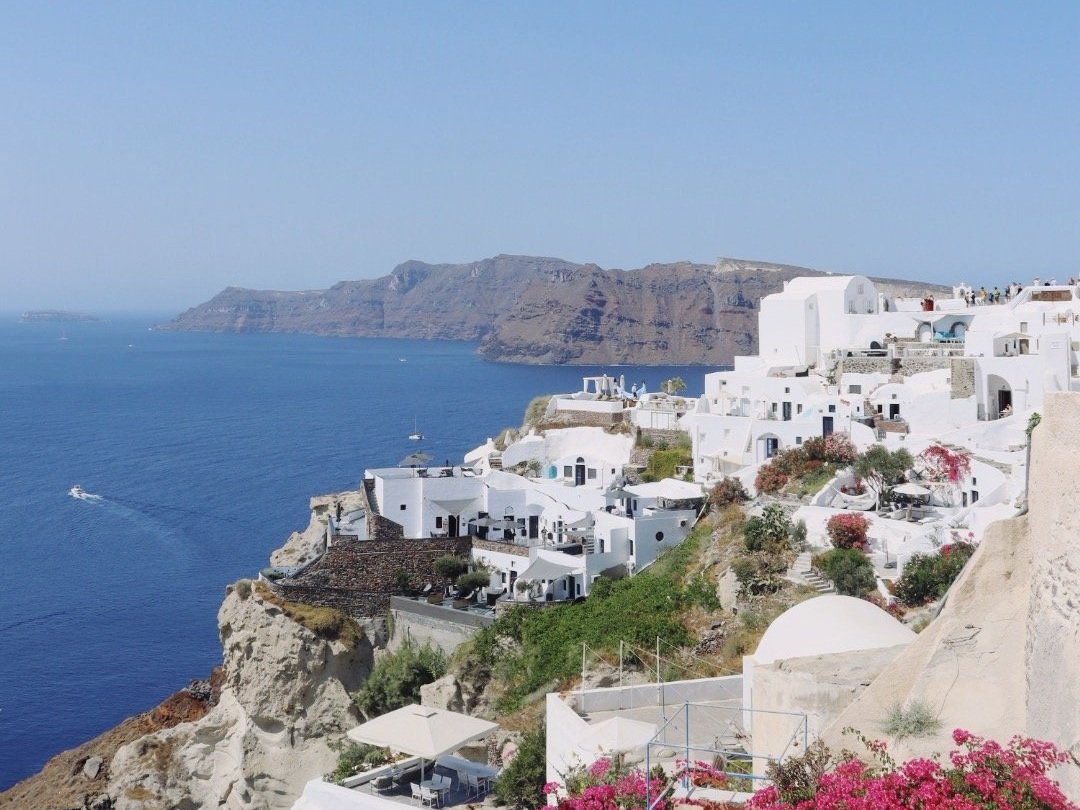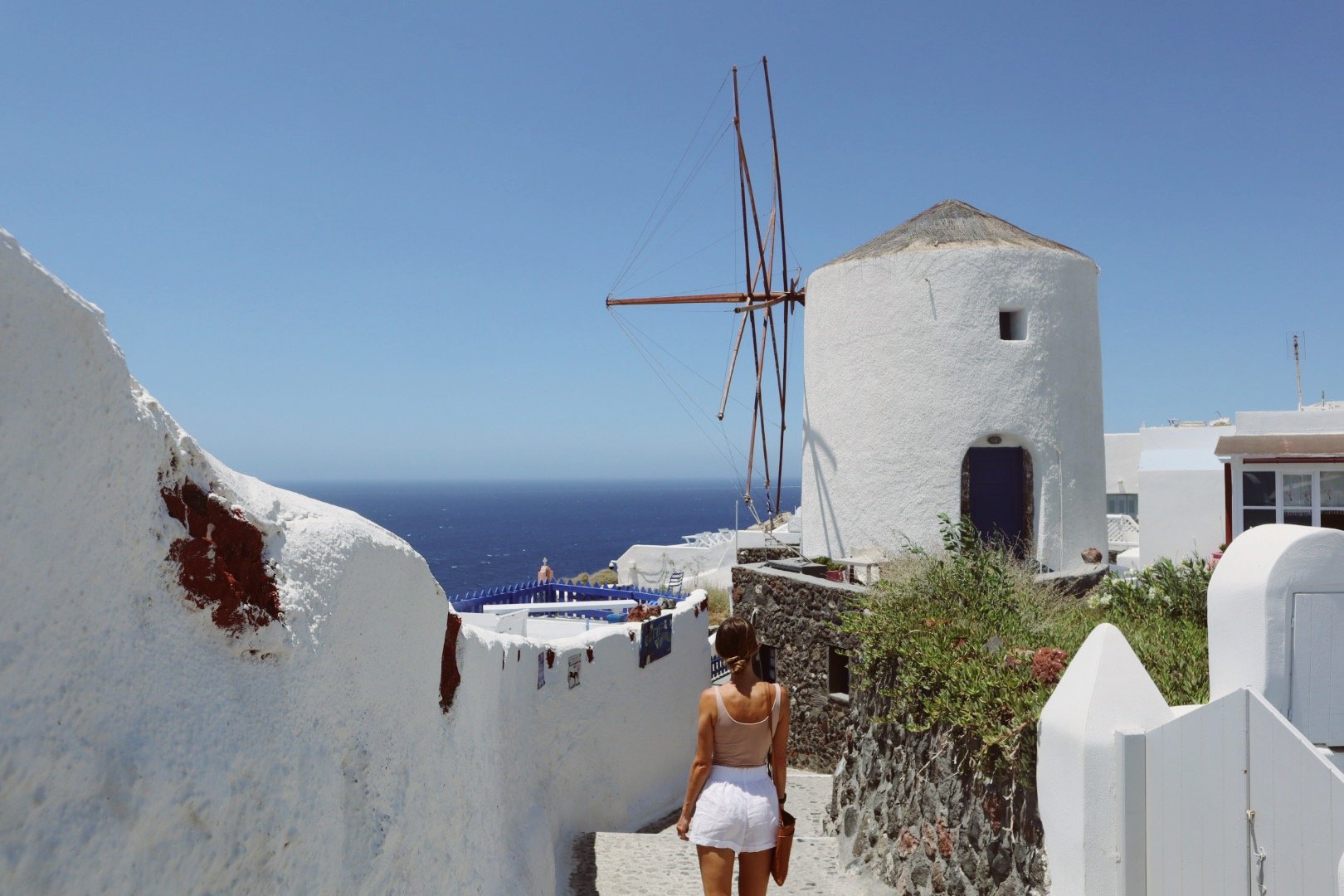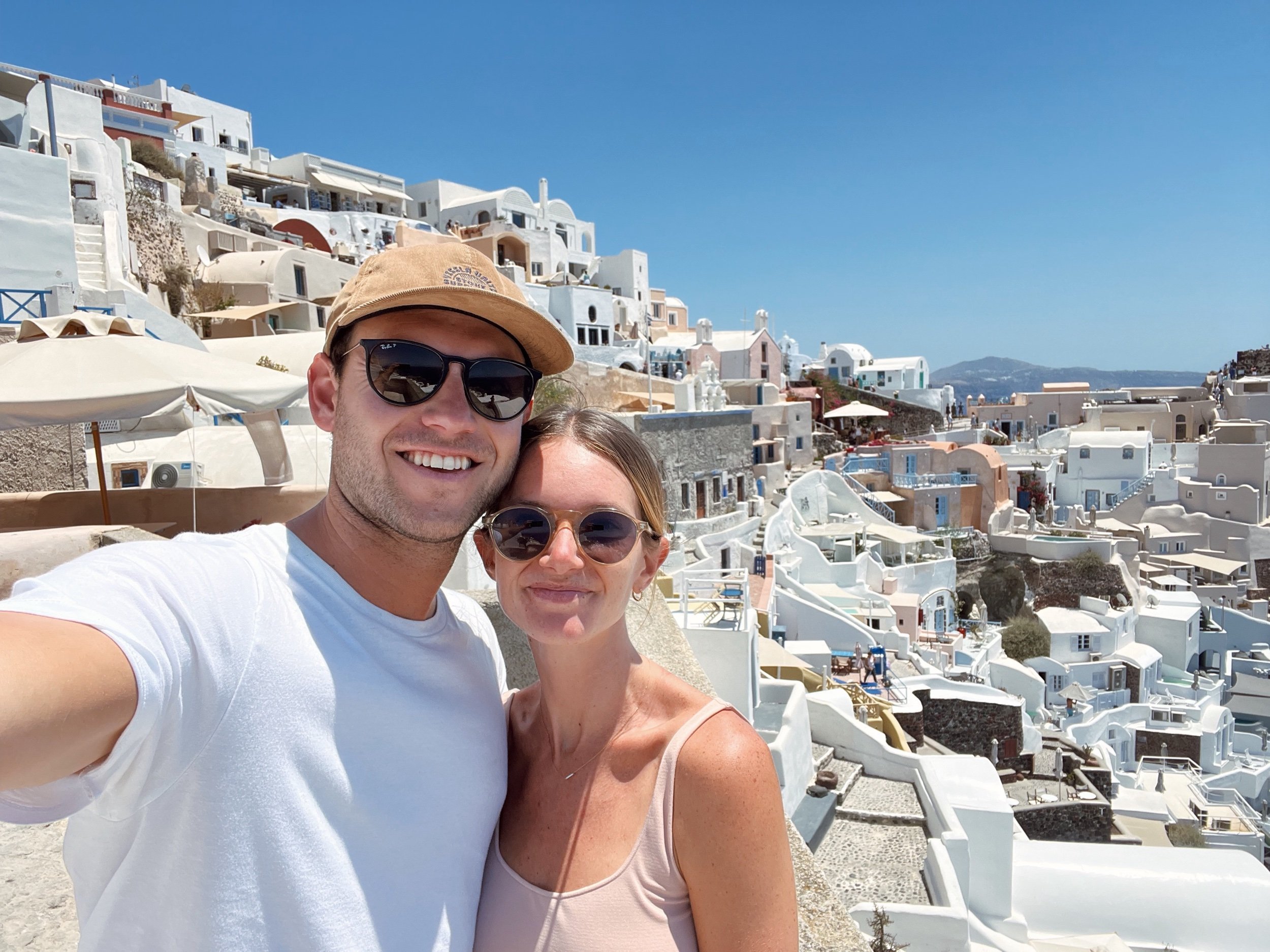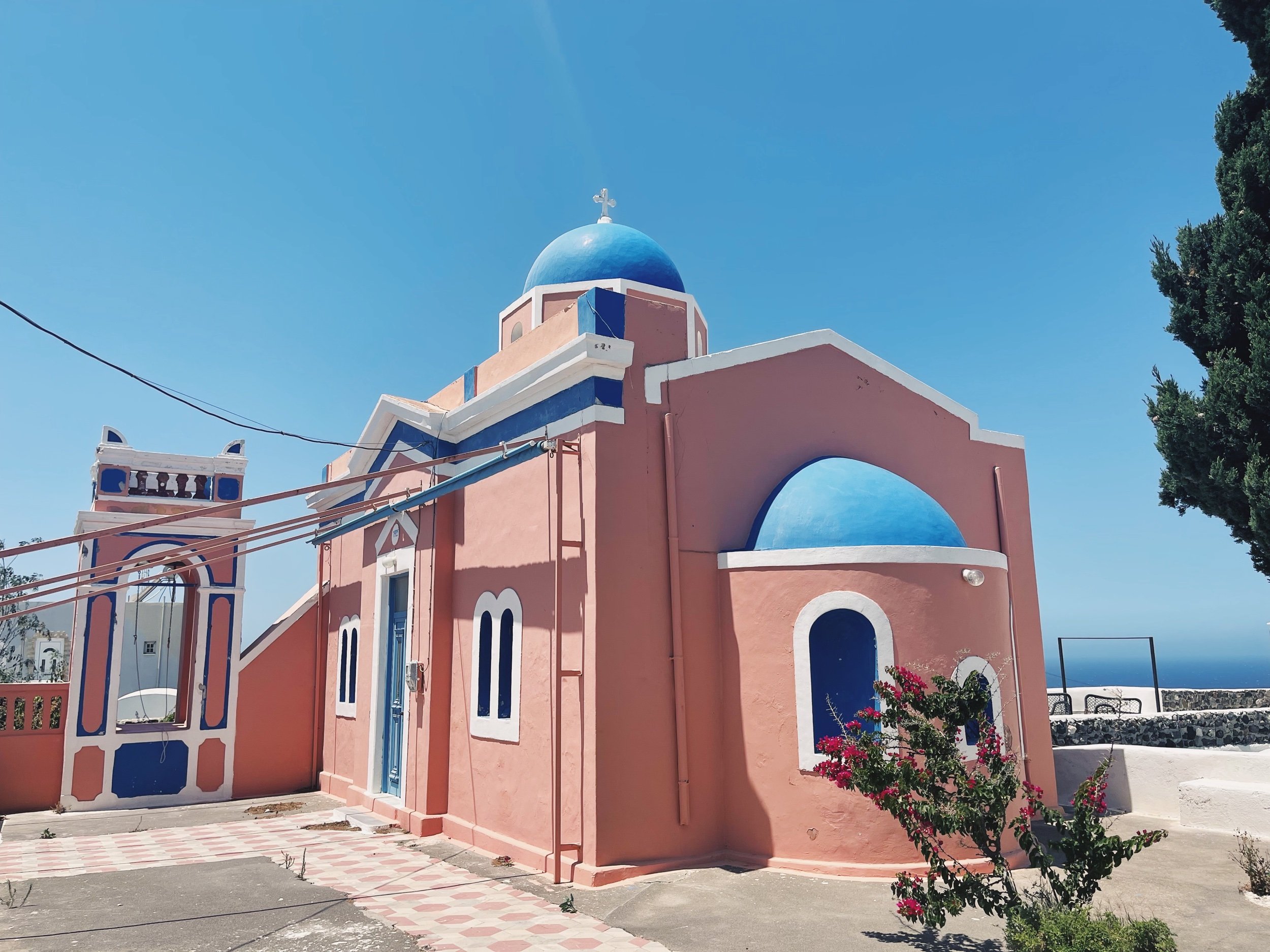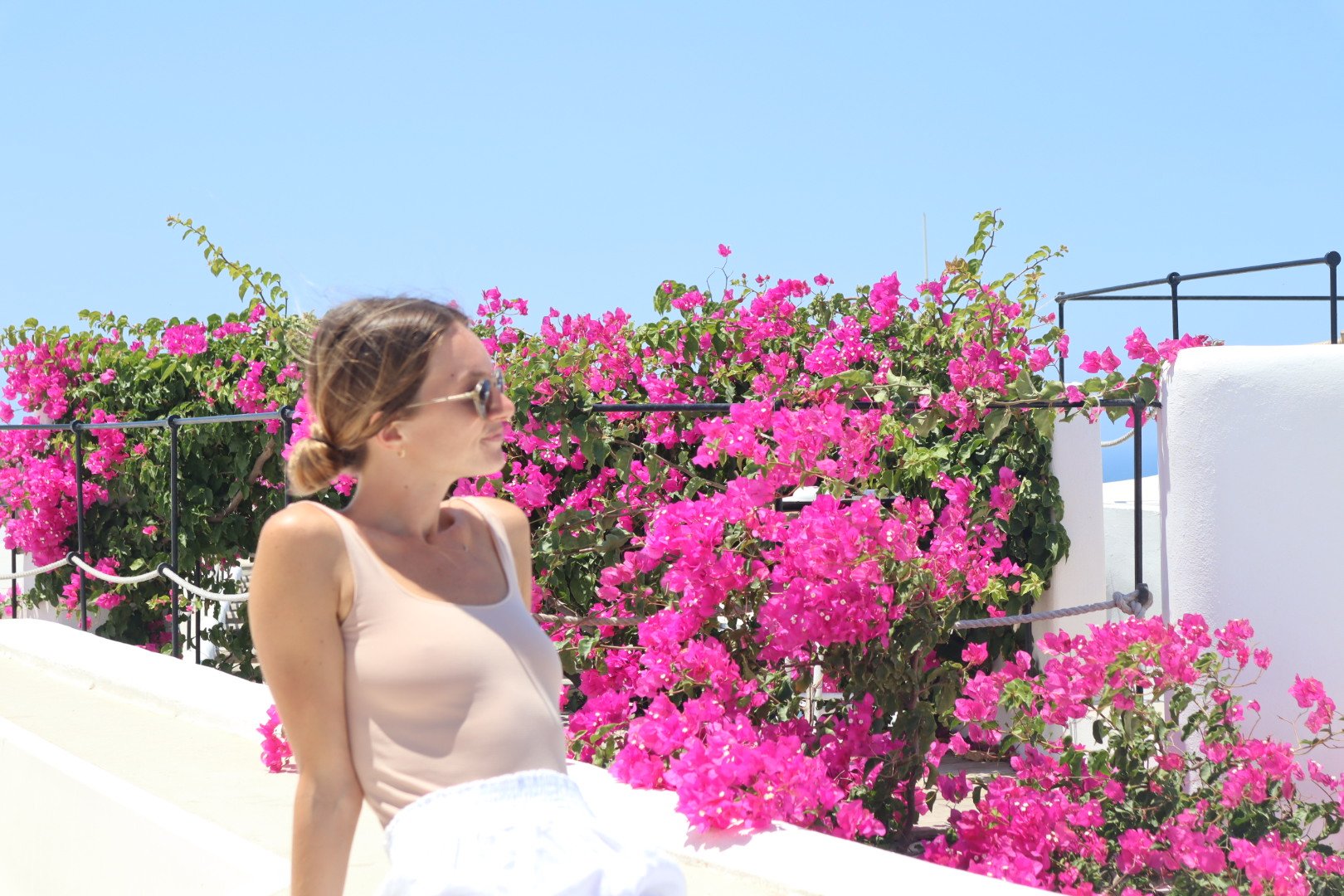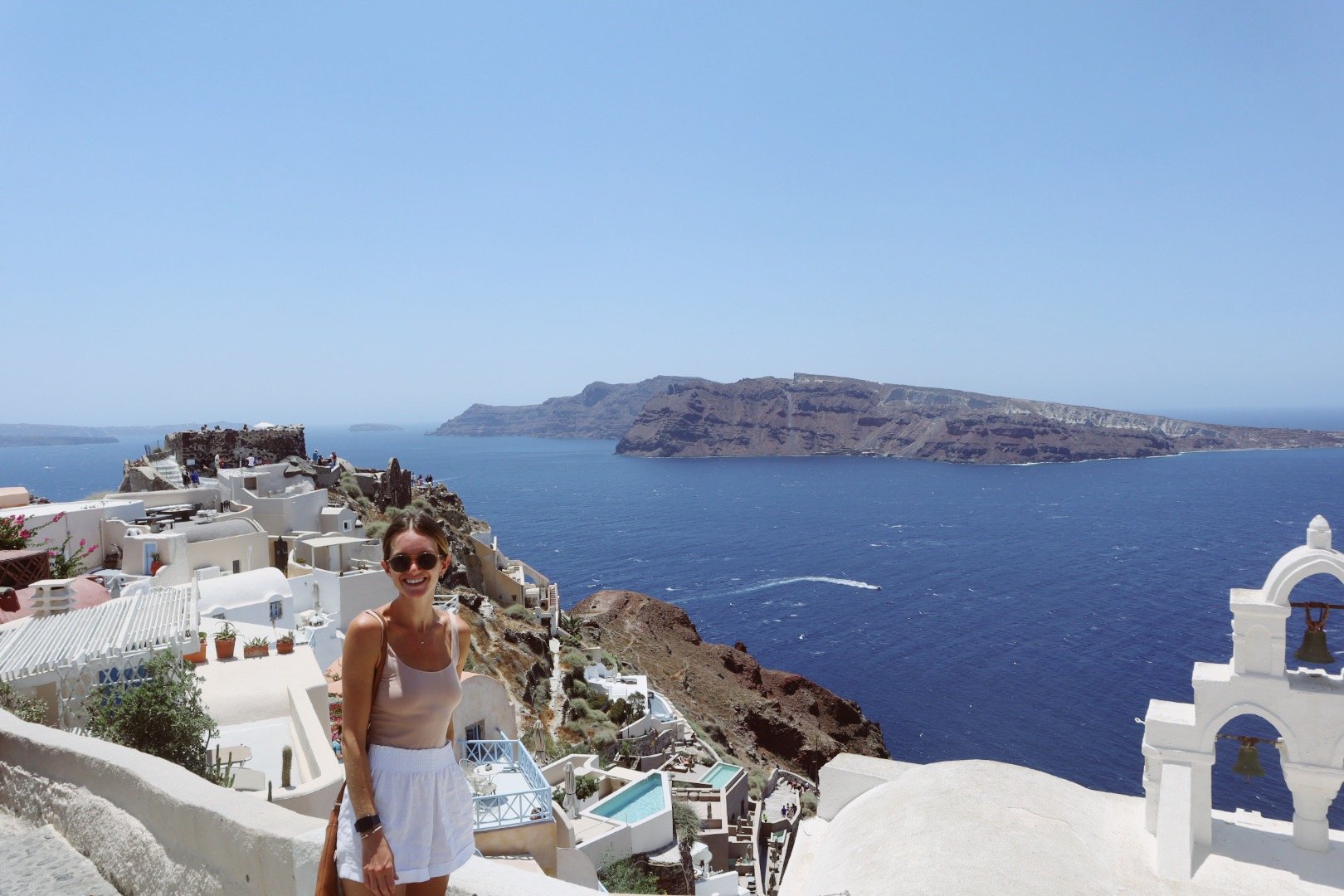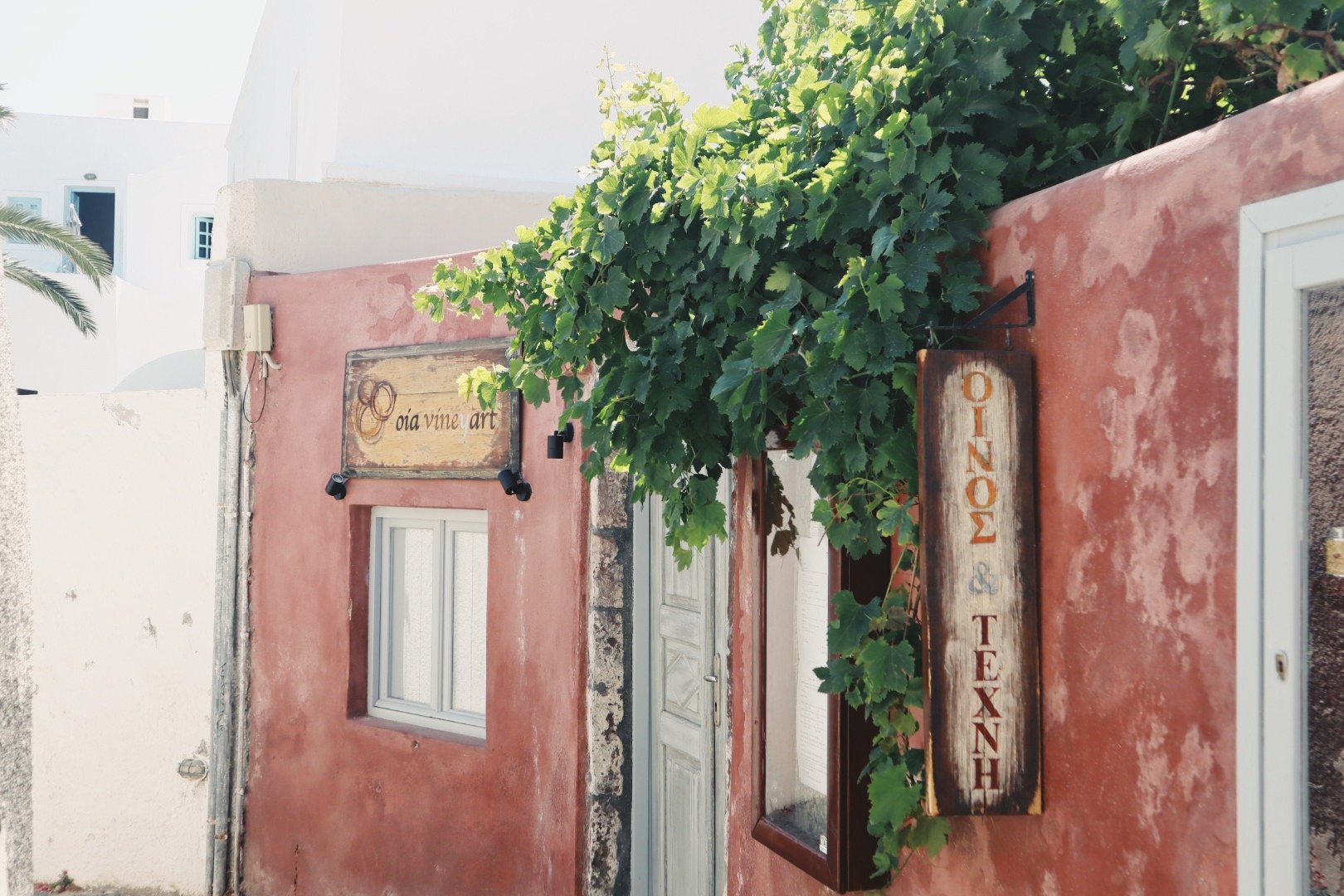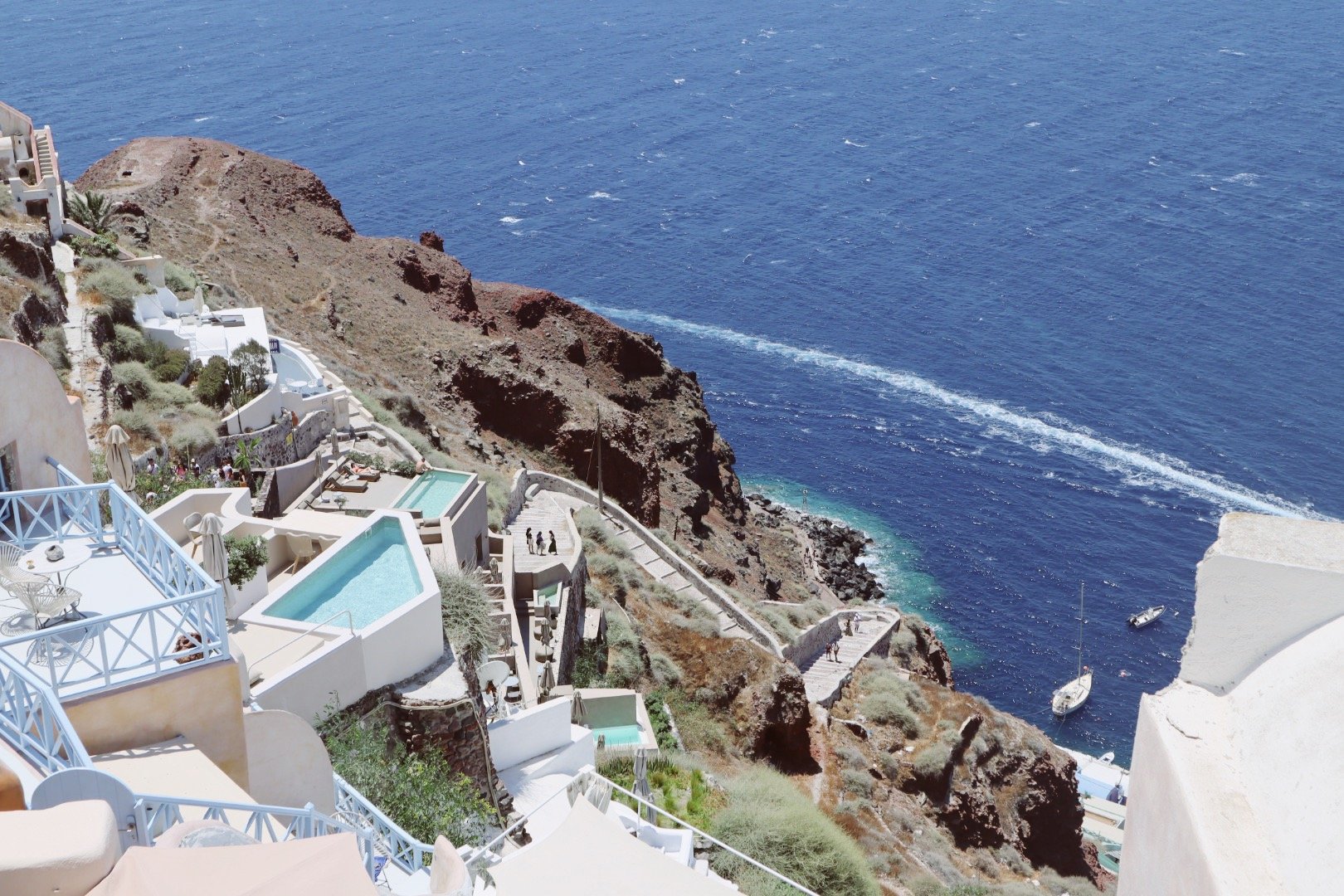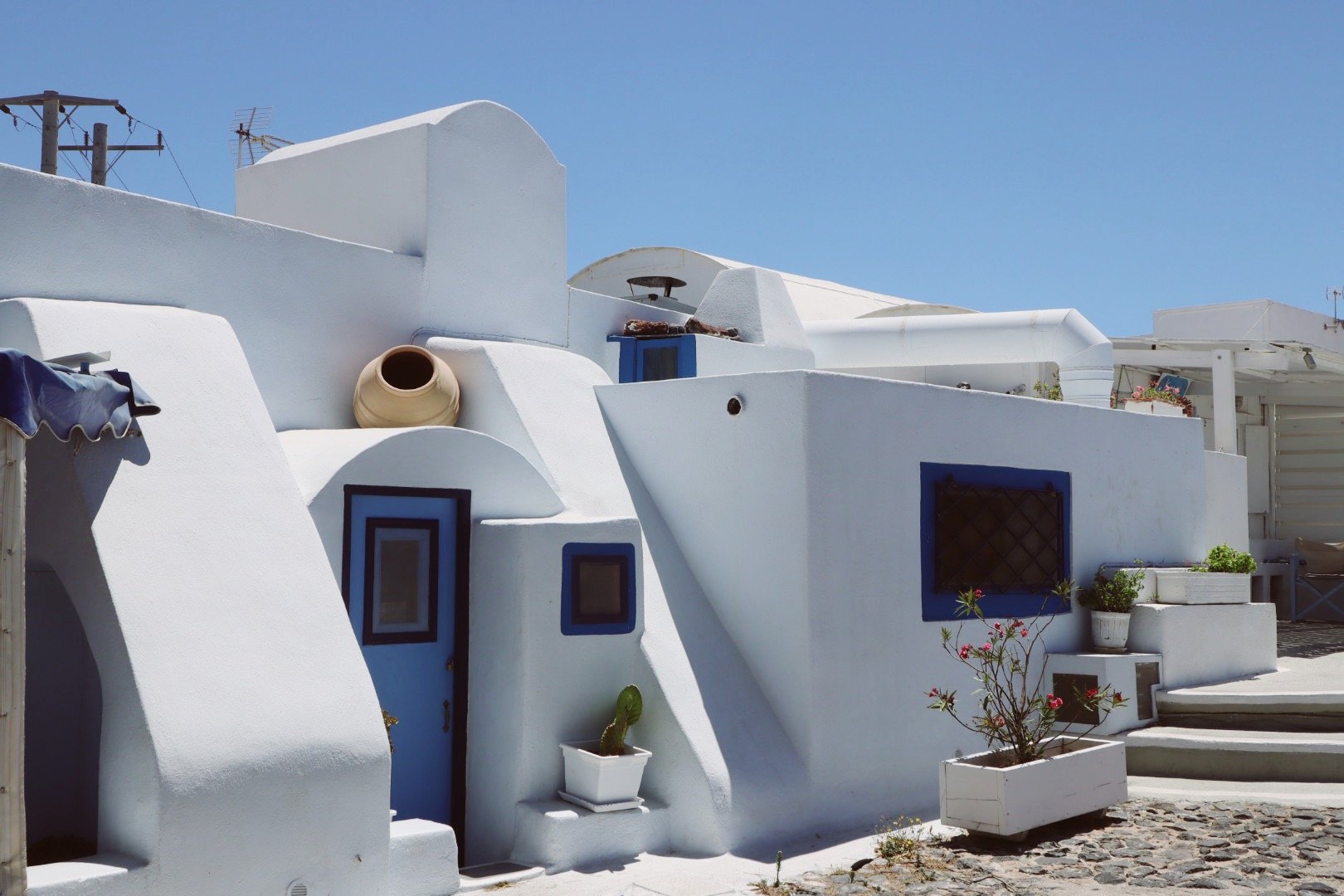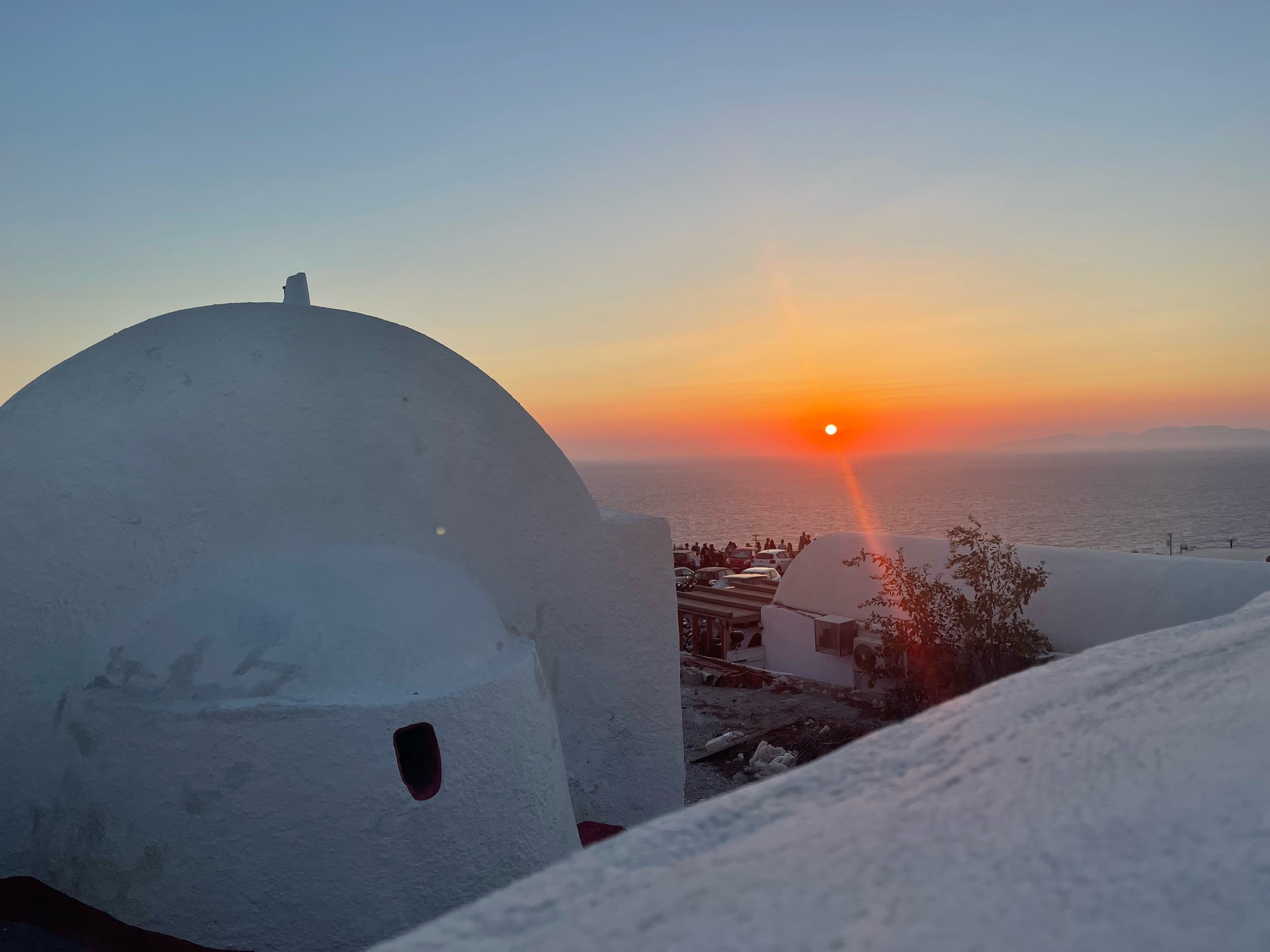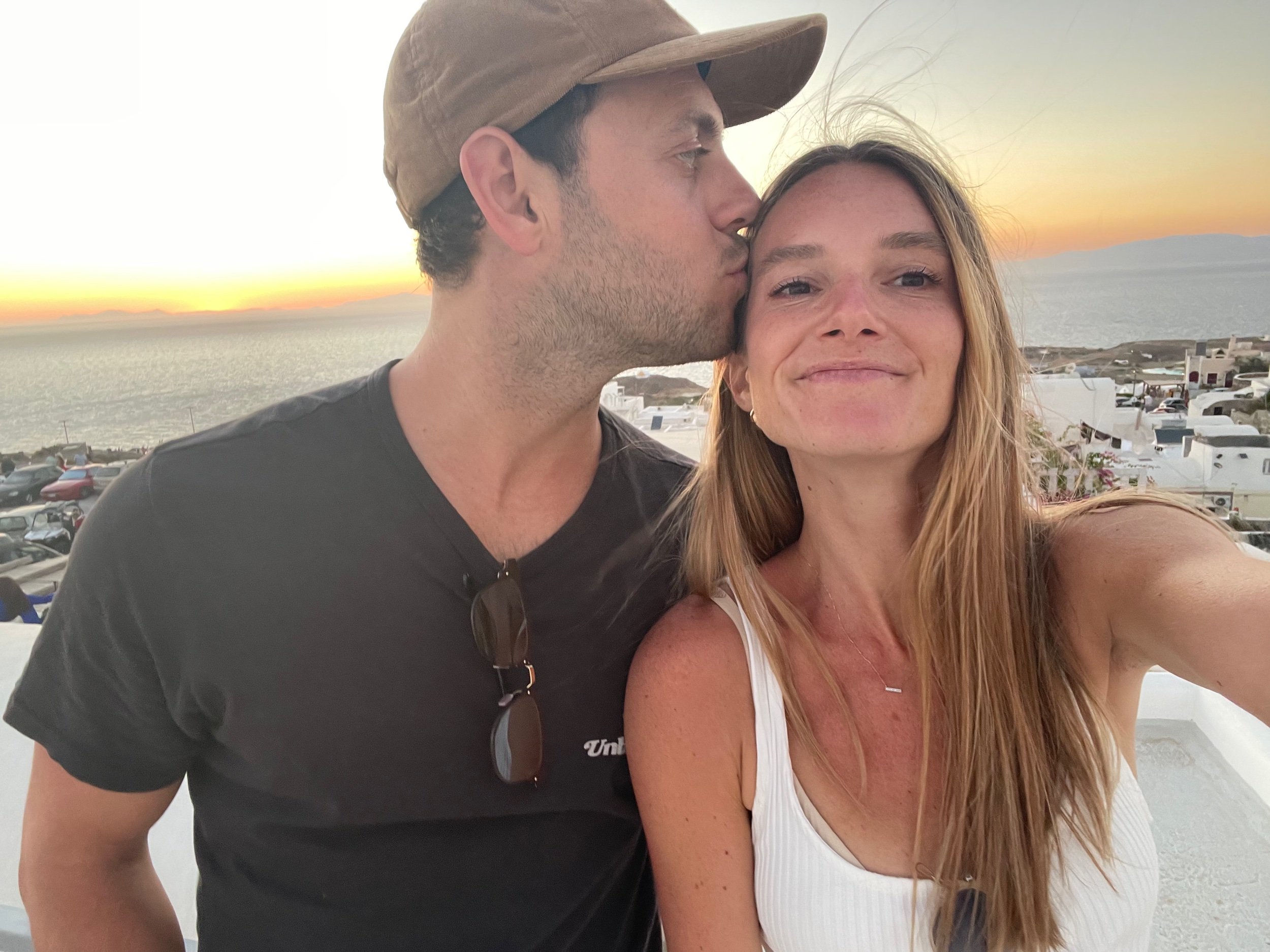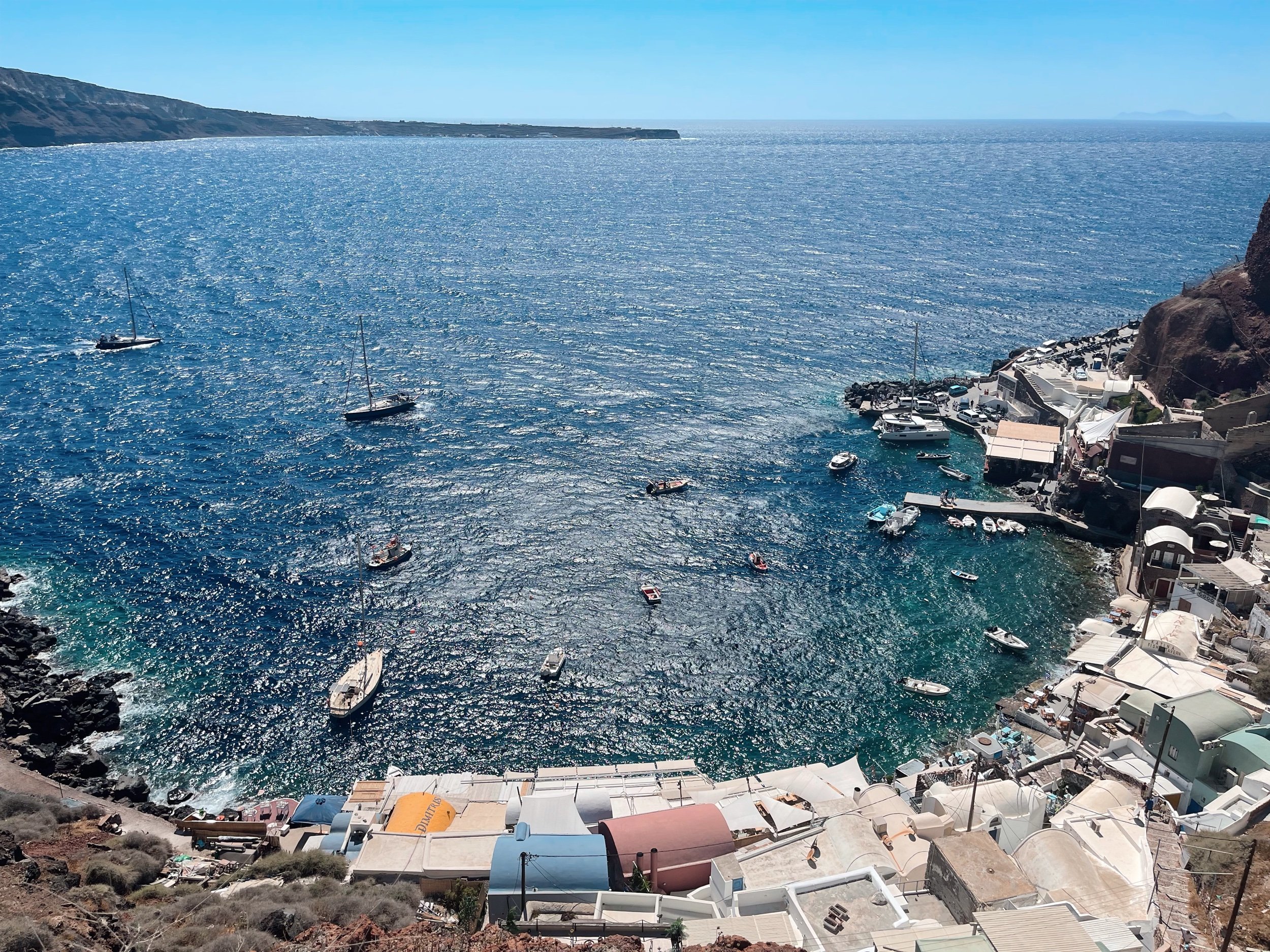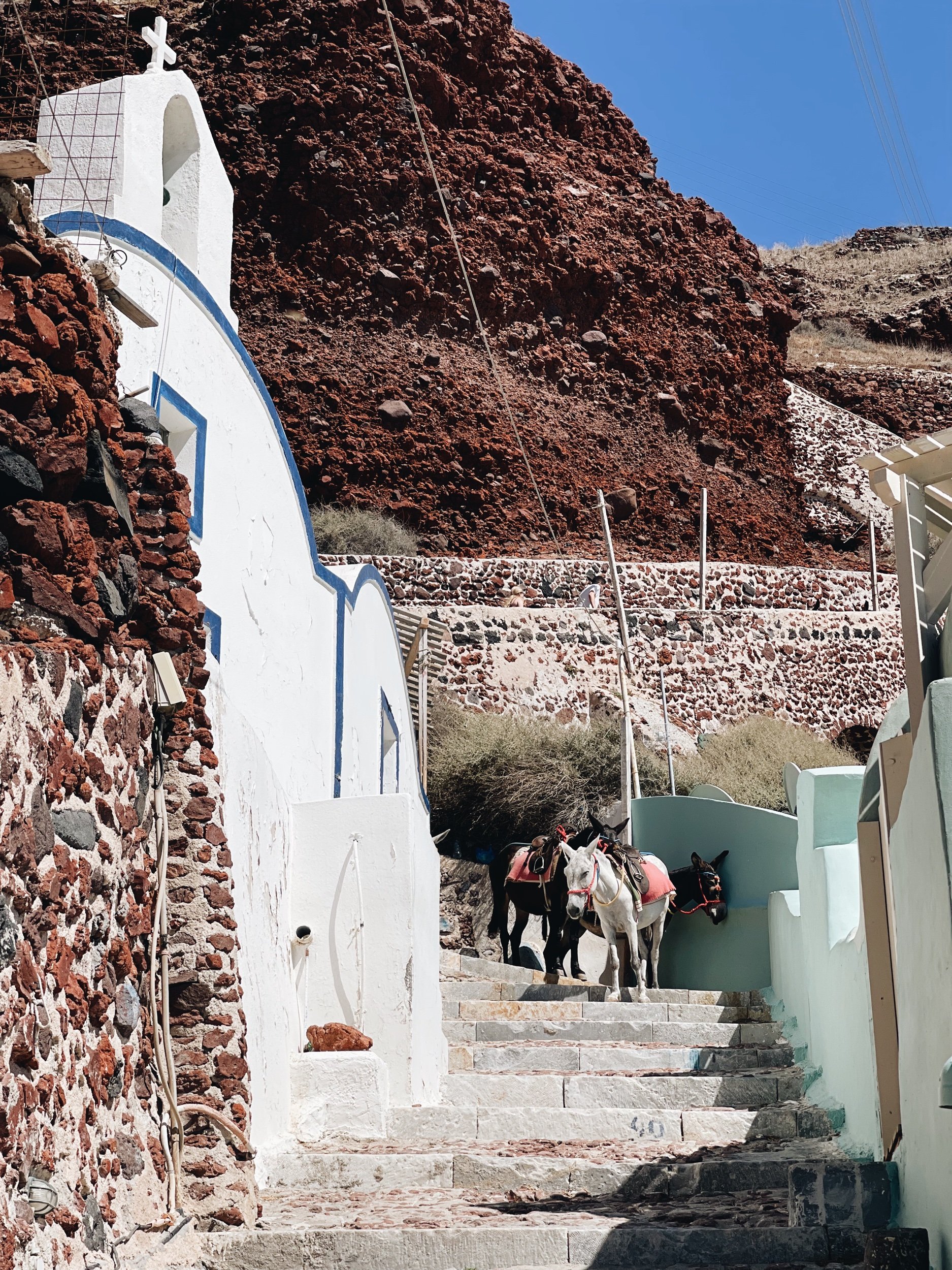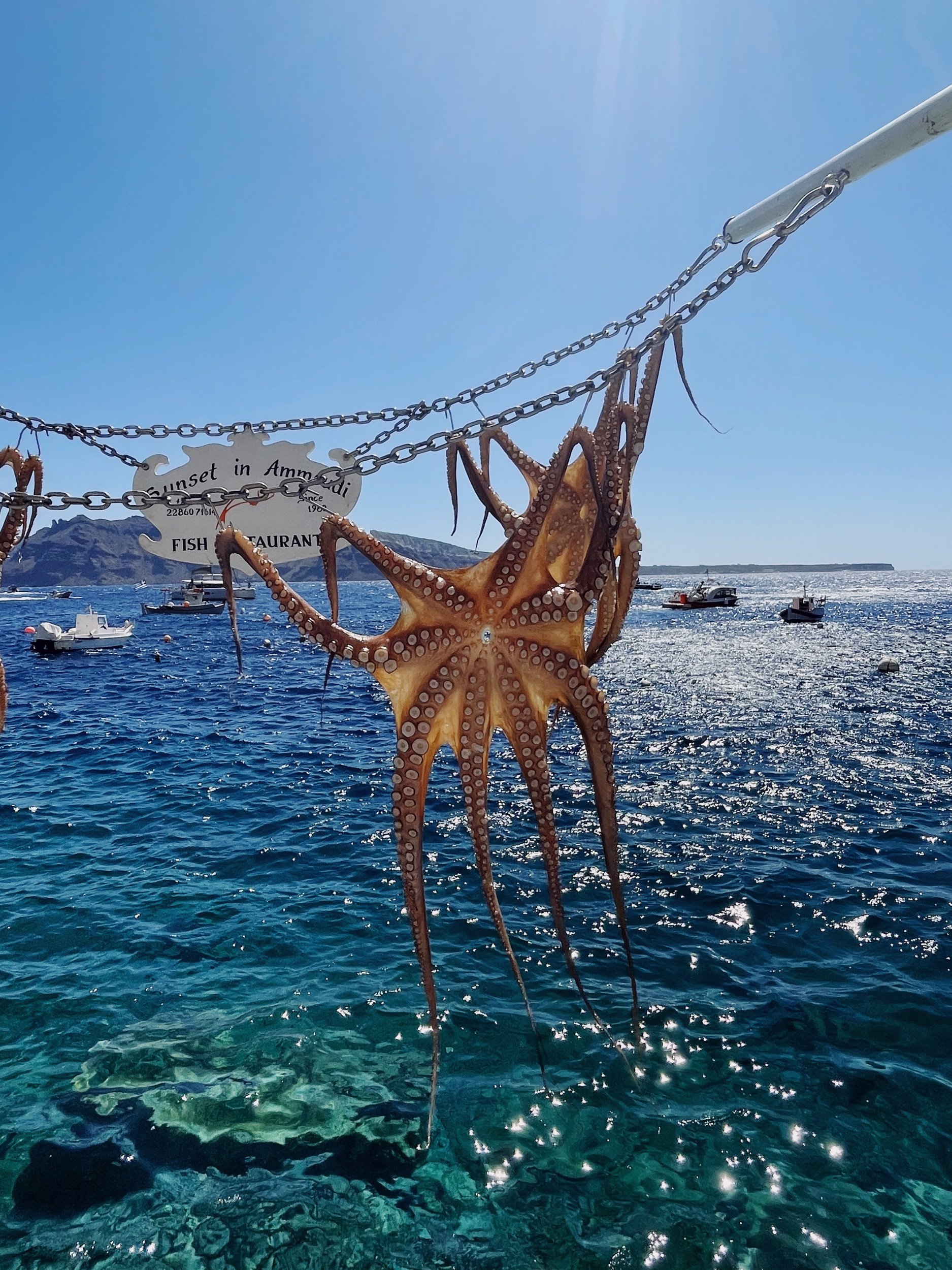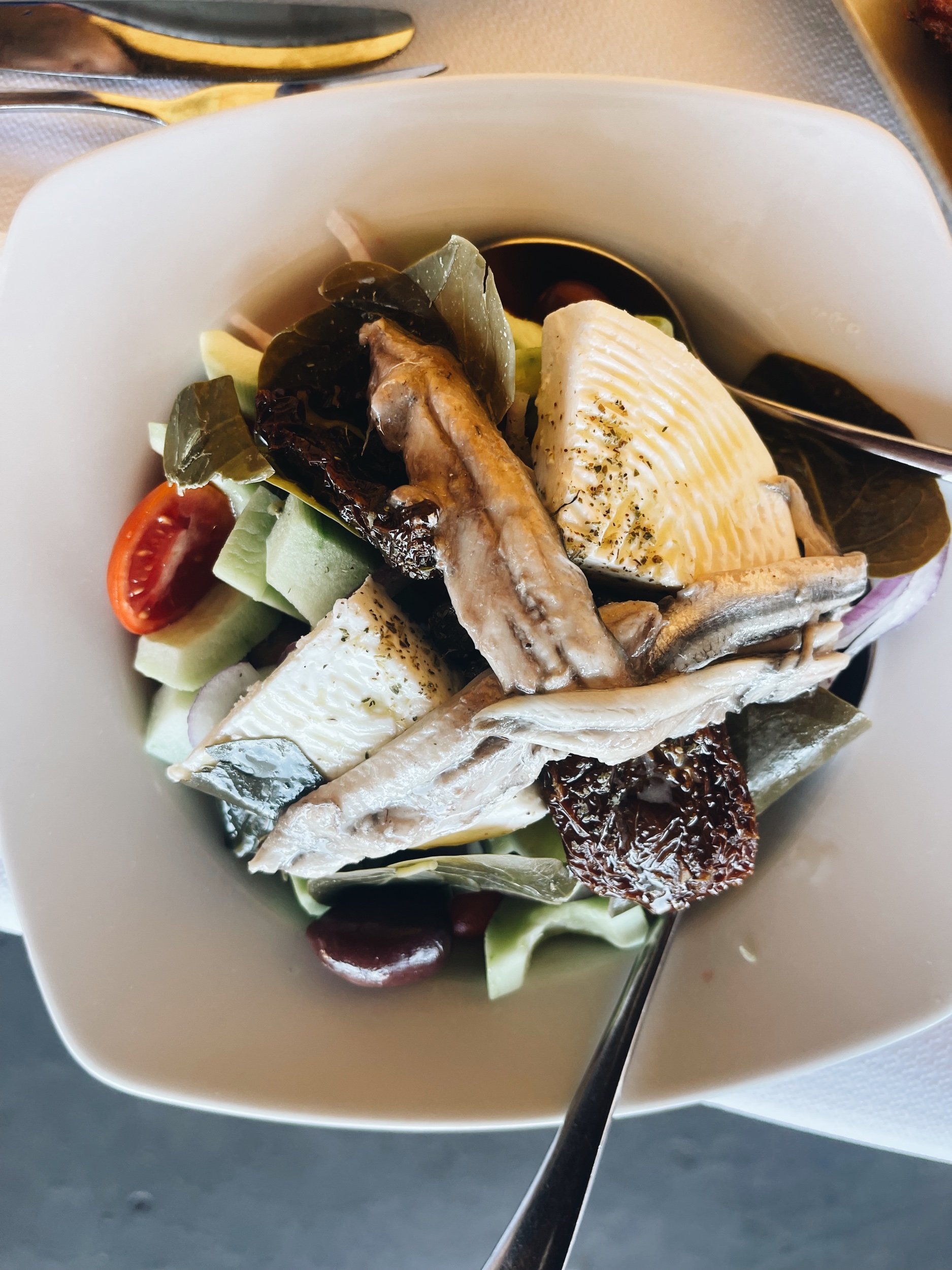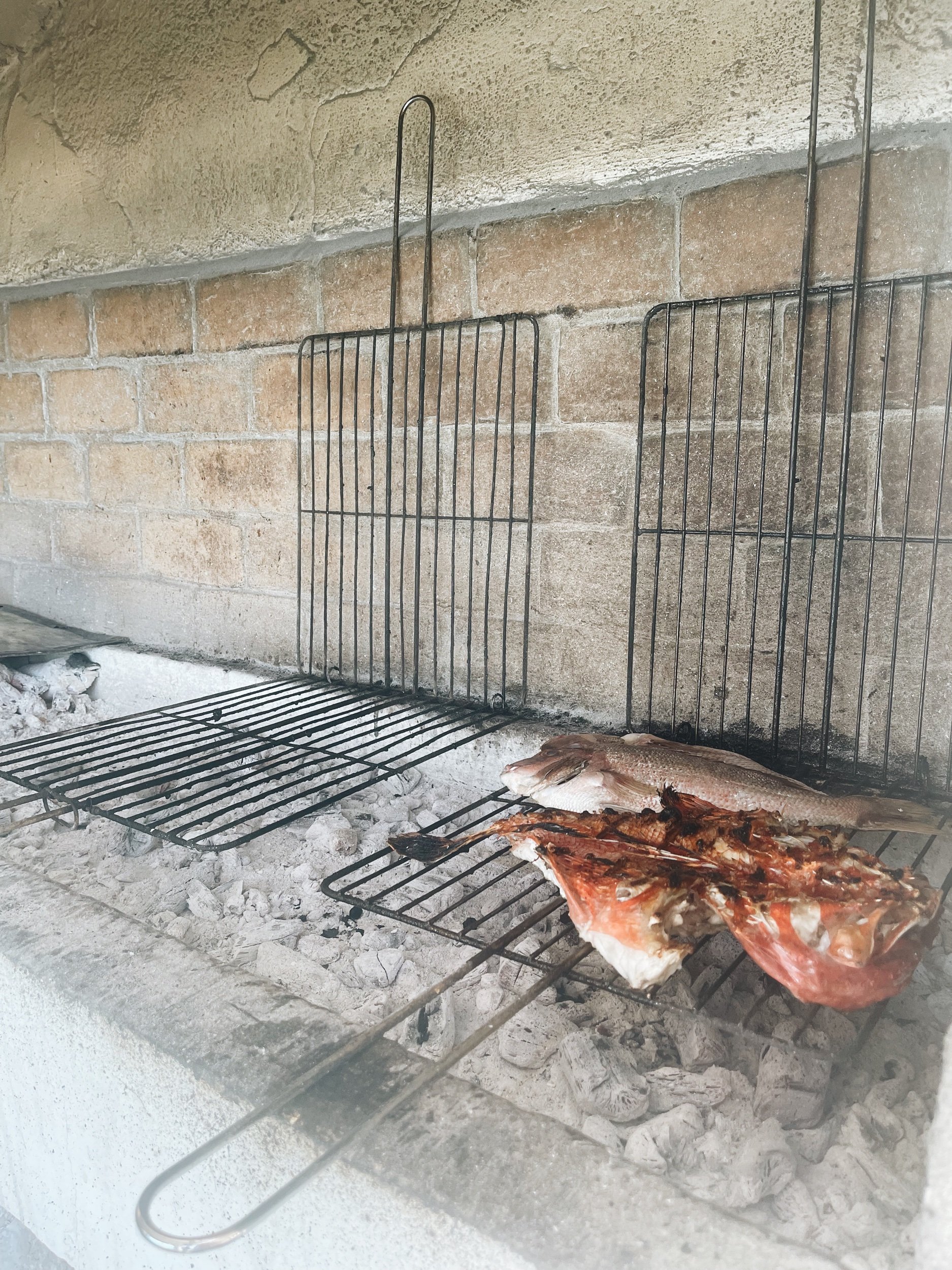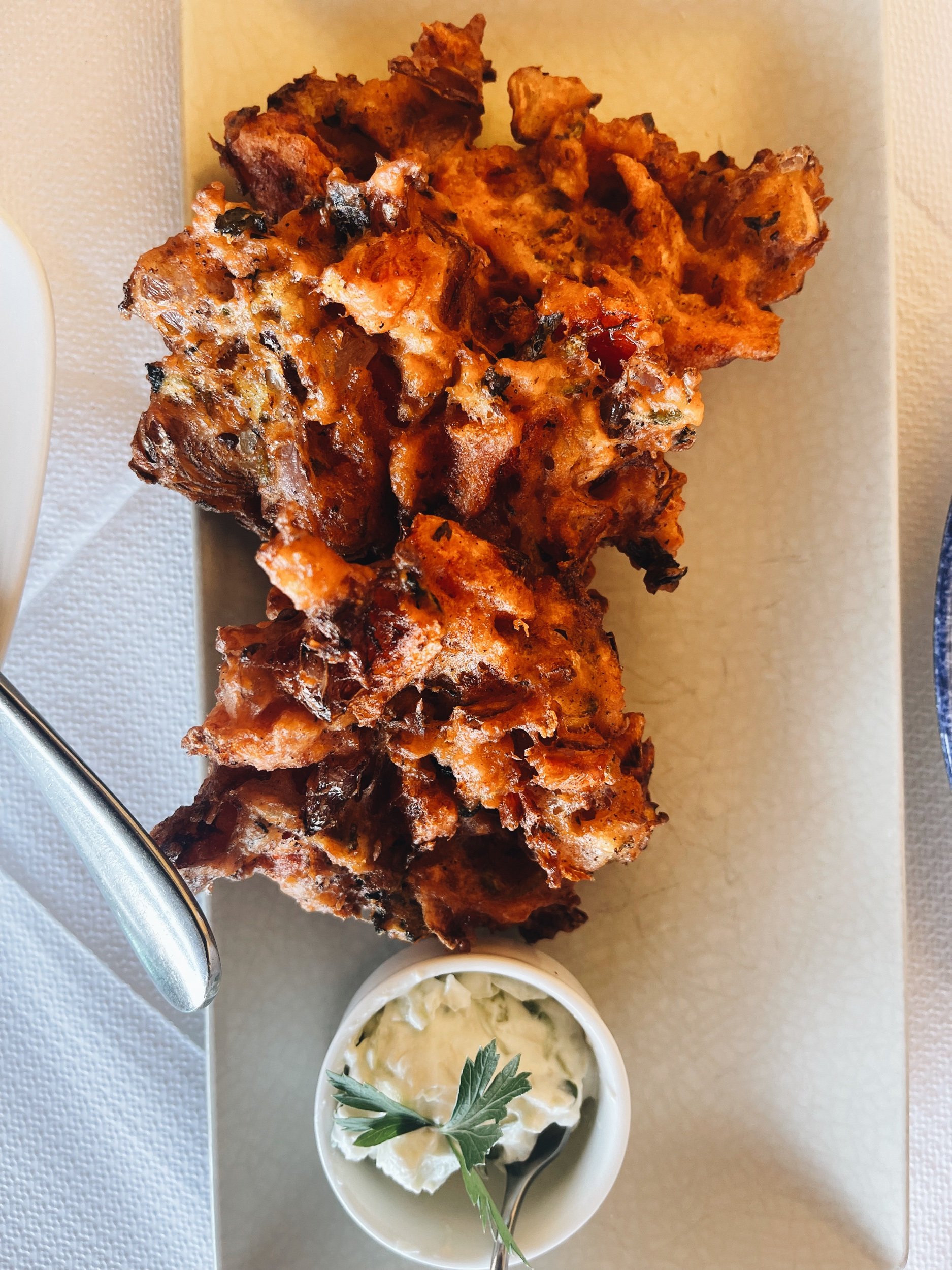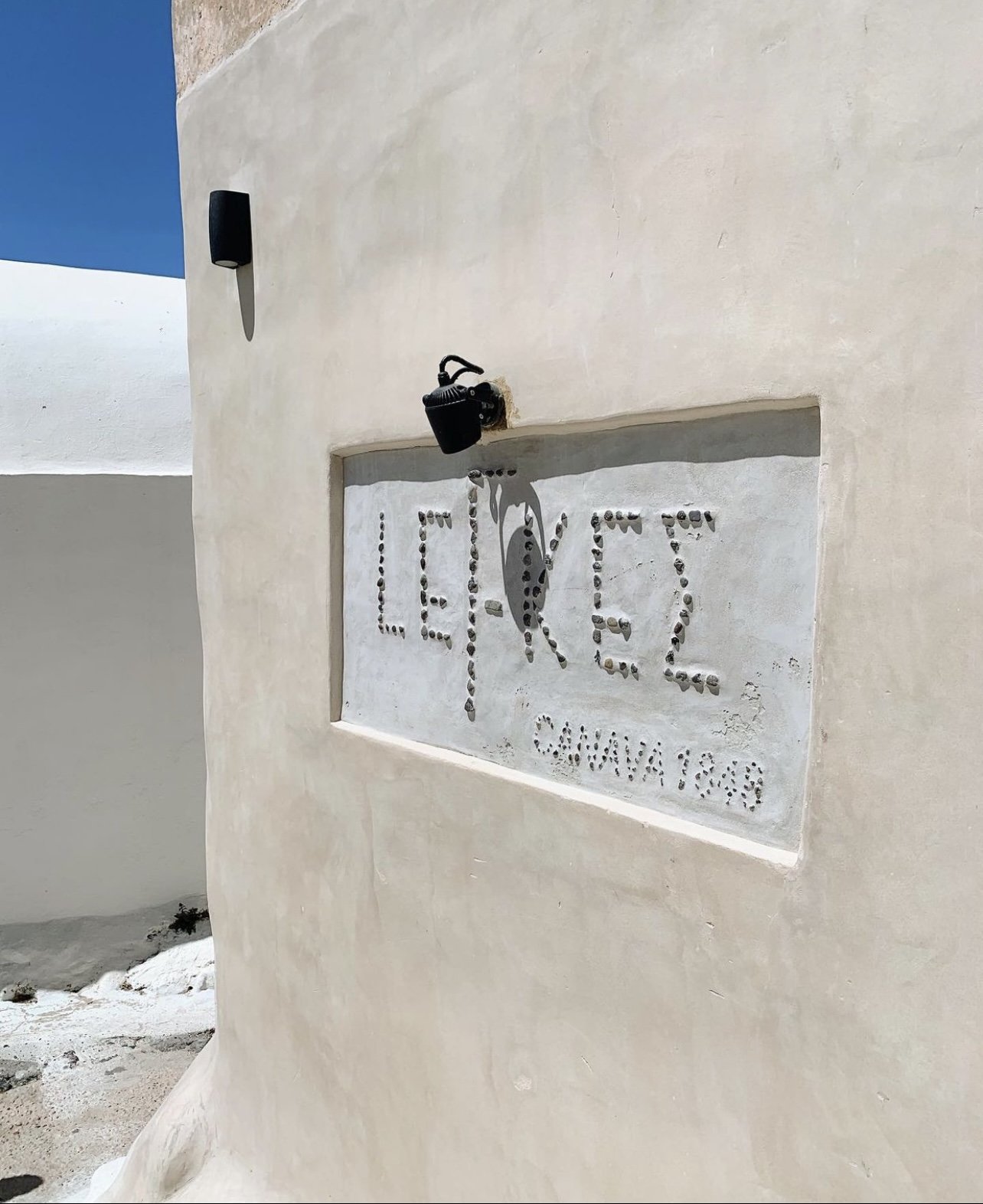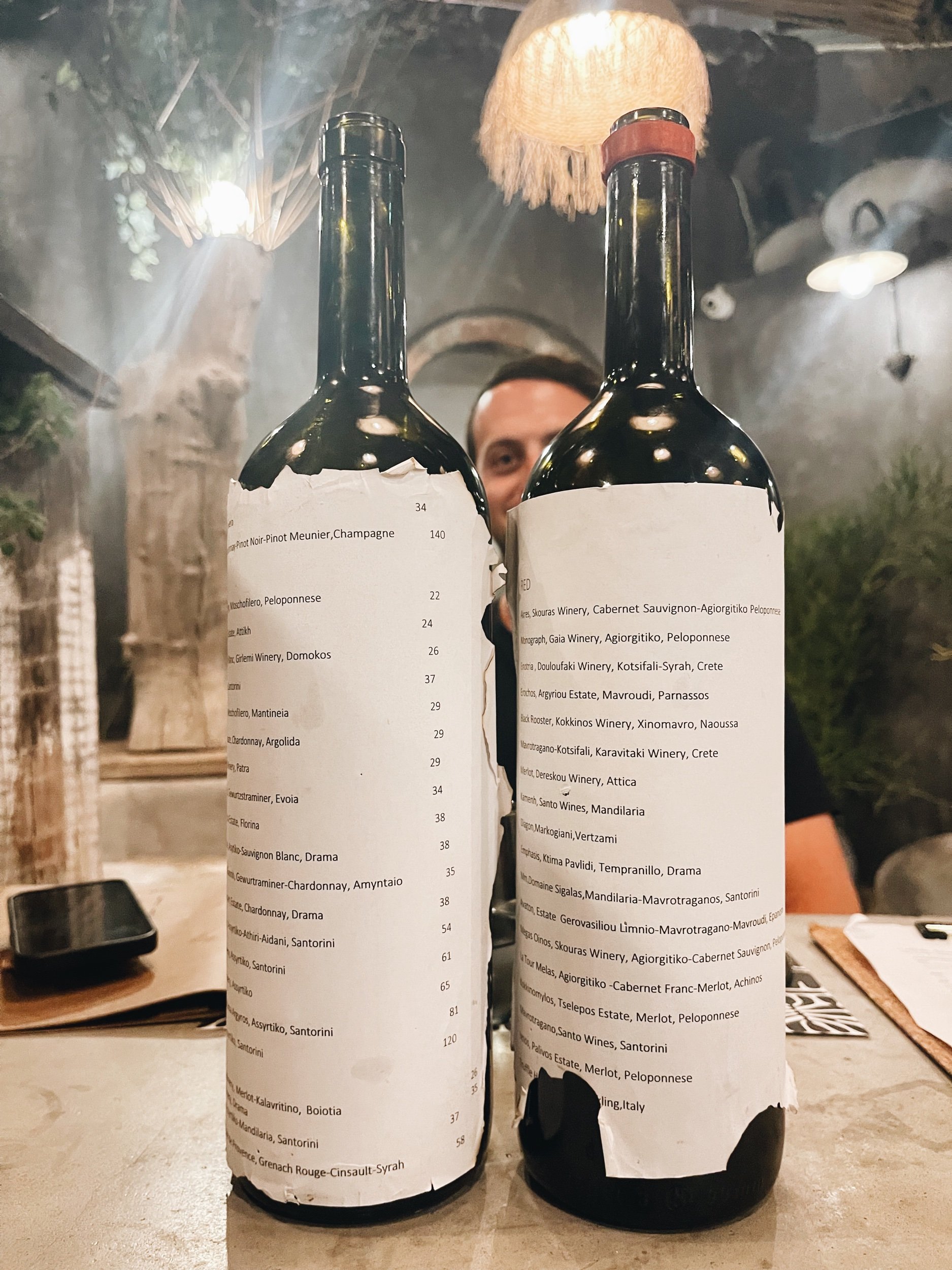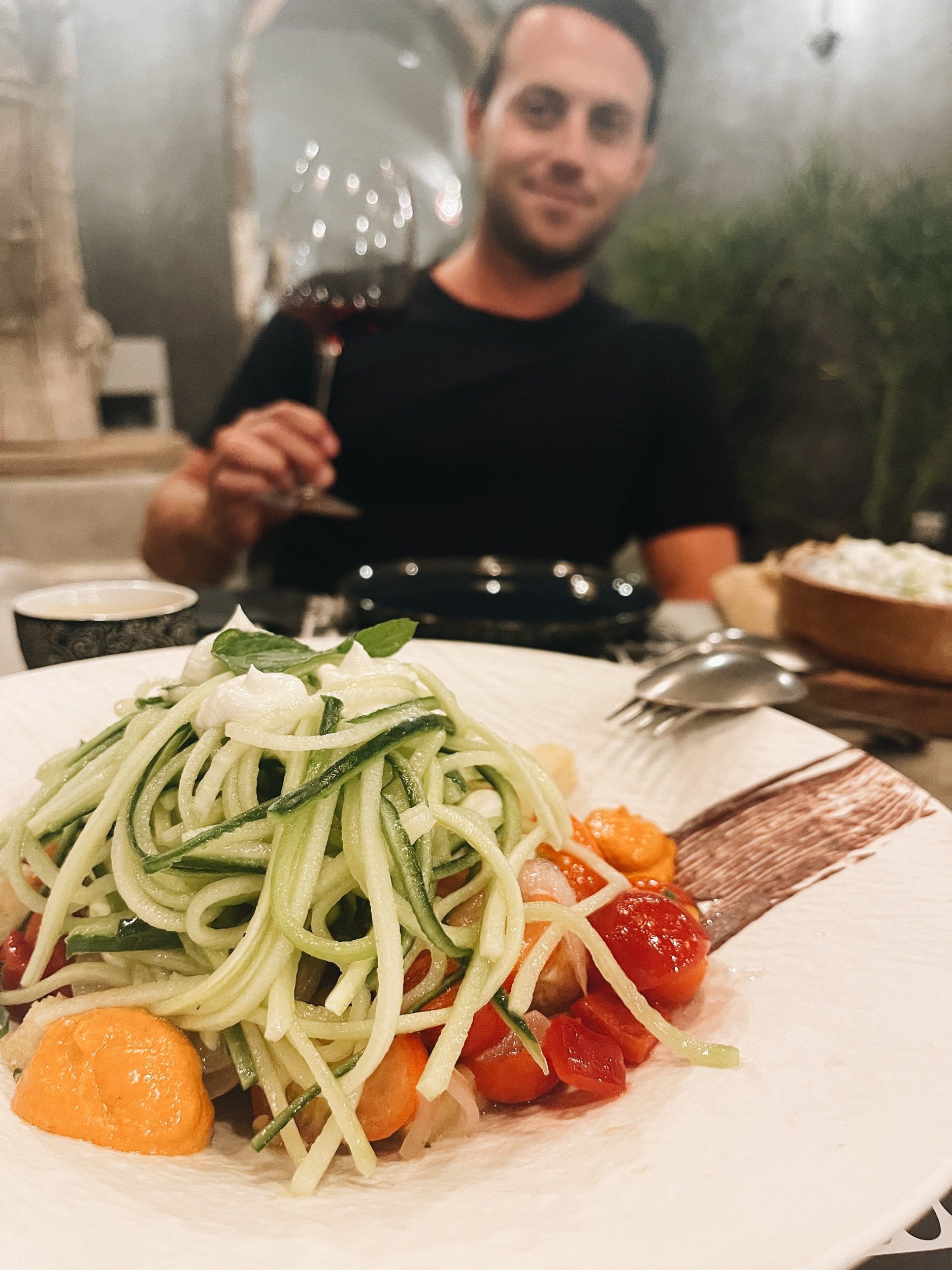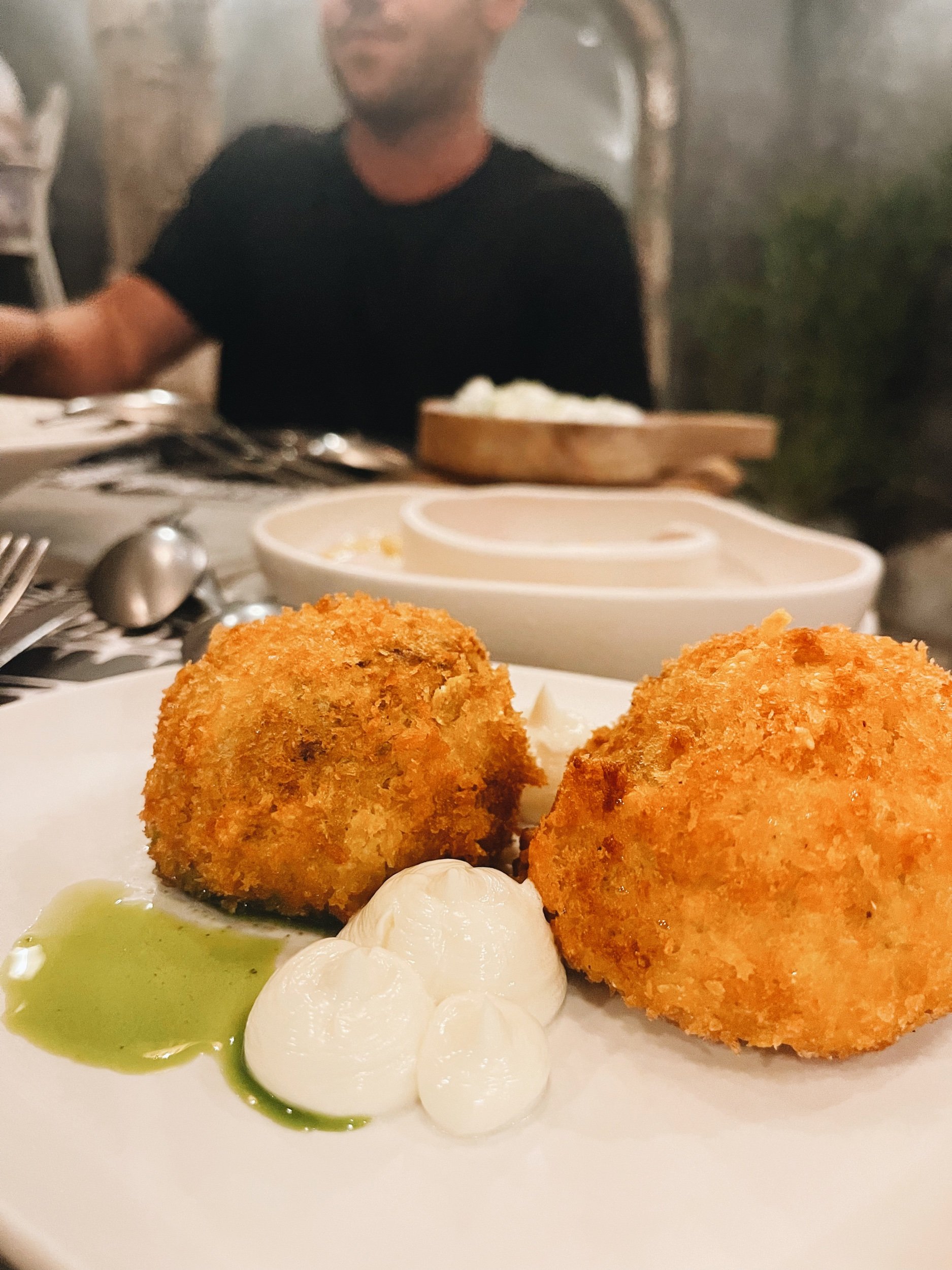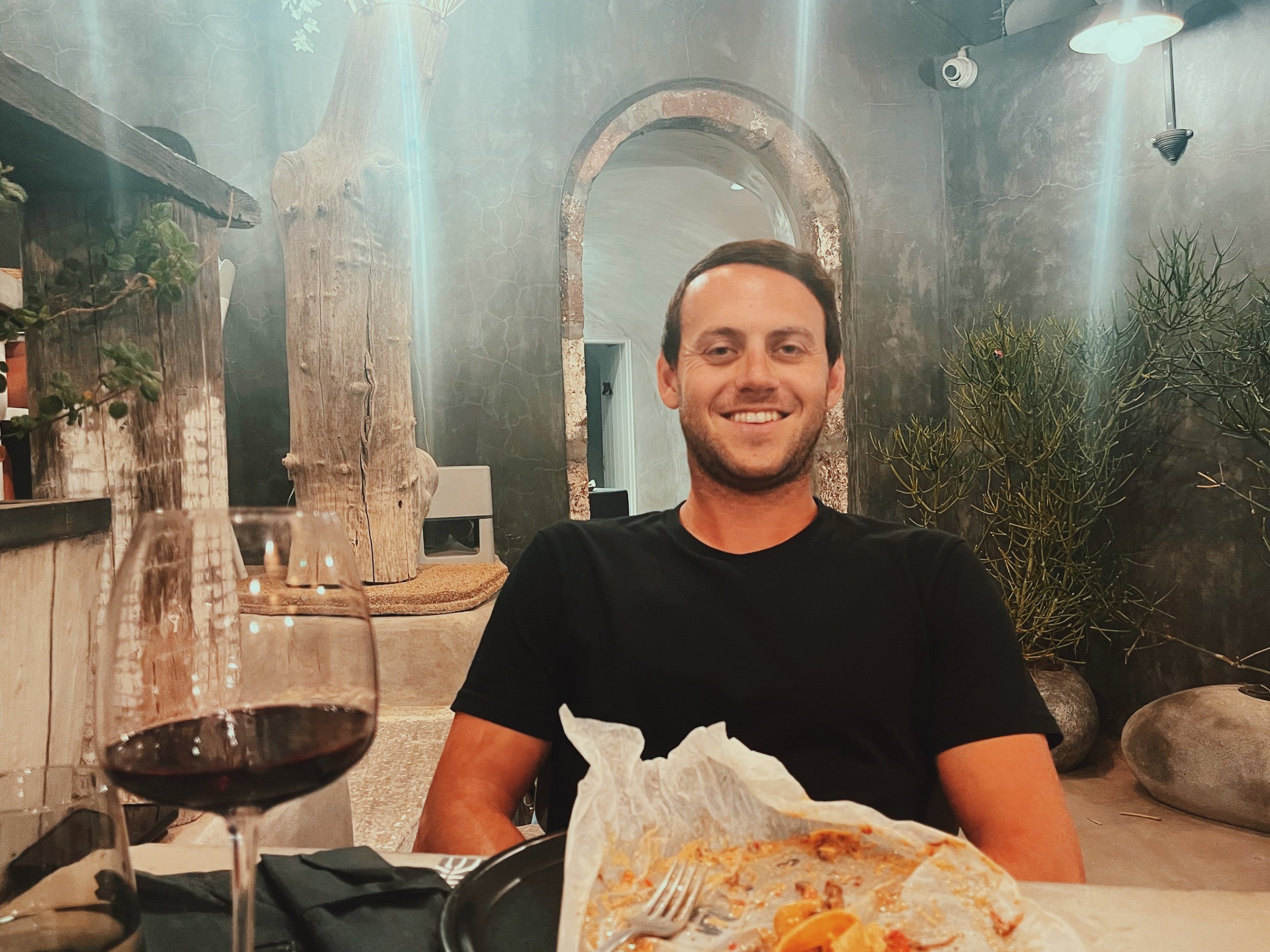Santorini Views
Insert synonym for bliss.
Dark volcanic rocks towered over the crystal blue waters, creating the iconic crescent-shaped island of Santorini, Greece. As we flew in, I could point out the faintest outlines of white-washed homes sprinkled across the jagged coastline, but I wouldn’t realize the striking beauty of this island until we arrived in the town of Oia.
White caves created domed arches across the horizon, separating the light blue skies from the deep blue waters. Pops of fuchsia intertwined with the white stone and blue roofs, creating a truly surreal onset. I had seen countless photos of Oia and knew the windmills from memory. But that first moment I laid eyes on the white stone against the ocean opened a new level of architectural admiration. We spent our first morning wandering around Oia, getting lost in the alleys and noting restaurants we needed to try. Just beyond a peach-colored church, we ascended winding stone steps while possibly trespassing to a rooftop away from the crowds below. It was strikingly quiet. We took in the uninterrupted views of the Aegean Sea, knowing we had found our secret spot for sunsets.
This secret spot proved to be invaluable as we ventured out on our first evening. Oia is the sunset capital of Santorini, and visitors from all over the island flock to the crowded alleyways to catch a glimpse. Tourists pour out of tour buses and taxis line the outskirts of town. The whole scene quickly transformed the romantic ambiance into into a chaotic Greek Disneyland. While braving the crowds was less than ideal, we traced our steps back to at our secret spot. With wine in hand of course. A peaceful stillness began to blossom as we poured ourselves a glass of Assyrtiko - a Santorini white varietal - and took in soft oranges and pinks melting in the sky.
Amoudi Bay had a reputation of a bustling atmosphere and fresh seafood. That’s all I needed to hear to justify the trek down 300+ slippery steps on our second day in Santorini. This walk was not glamourous. The stench of donkeys (and their droppings) filled the air, but each step down offered a closer view of the sparkling bay that was tucked under the towering cliffs. The rocks that lined the path down were volcanic red and contrasted the darker asphalt colors we’d seen the previous day. When we finally took our last step down the stairs, a narrow path carved out of the jagged rocks came alive.
Cafe tables lined the water’s edge and visitors filled up the open crevices between tables. Boisterous conversations filled the air of the restaurants and we slid through the crowds, making our way to Dmitris. To be honest, the casual fish-forward restaurant first reminded me of something I would see at Fisherman’s Wharf in SF. I had my hesitations - did I just sign up for an overhyped tourist trap? But as we were guided to our table, roasted vegetables and the salty, fresh seafood tickled my nose, quickly dissolving any trepidation. Our table was tucked by a grill with metal racks fasten atop white embers where whole fish slowly roasted for hungry patrons. The smell ignited my appetite and we were quick to decide on our order: greek salad, eggplant, tomato fritters, and octopus.
After reflecting on our time in Greece, I’ll be the first to admit that I held zero restraint when it came to ordering a greek salad. Some - i.e. Michael - might say I overdid it but I was magnetized to the crunch and juiciness. And I was possibly trying to counterbalance all the meats we ate in Central Europe.
At Dmitris, a large plate was filled with hefty chunks of fresh tomatoes, cucumbers, onions, olives, and caper leaves. Each ingredient tasted like it was straight from the earth - bursting with juices and flavors. The feta cheese was soft but didn’t overpower the flavor like many greek salads I’ve had in the states. The star ingredient however was the thin anchovies that delicately laid on top. The saltiness of the anchovies melted over the brightness of the vegetables, yielding to the perfectly balanced bite.
The next culinary surprise during our time at Dmitris: the tomato fritters. Usually I’m not a fritter orderer. I’m typically disappointed with the imbalance of over breading compared to what is being frittered. I didn’t think it was possible to achieve a bright flavor in a fritter dish. However, tomato fritters were a staple dish in Greek cuisine and Dmitris’ menu called it out as a specialty. When I took my first bite, I was astounded by the burst of fresh juice from the the tomato that hadn’t been dried out from the fryer. The breading was lightly coated around the tomato and there was a strong herbed salt that qualified this dish as addicting.
We left lunch extremely satisfied but there was more to Amoudi Bay that we set out to discover. A small path came into view just past Dmitris, and soon I found myself on a small hike in sandals. Ten minutes passed and the path opened to another bay sparkling like a blue sapphire. We made our way down to the water and laid out two towels over the dark pebbles. I hadn’t jumped into the water since our time in Croatia so plunging in sent instant energy through my body. This was a reawakening. I let myself float along the coastline, taking in the surreal views of the dark volcanic rock and Cycladic architecture above and feeling the fresh breeze on my face. It wasn’t long before I started to get cold and make my way back to our towels. I may not be an ocean enthusiast like Michael but in that moment I felt immensely happy to be back by the water.
Our favorite way to experience any destination is through the region’s cuisine. For us, food acts as a small opening into the region’s history and the culture. Of course Santorini was unrelentingly stunning and we felt the romantic hype. But the small island was inundated with travelers trying to absorb that same magic, making it feel extremely busy. It’s difficult for this ‘high-season’ setting not to overshadow the beauty. What helped defined our experience here, leaving us with a tasteful desire for more things Greek, was our final meal at Lefkes in the small village of Finikia.
Finikia was a modest village of Oia, where less crowds flocked the winding stone streets. Rather than retail shops and tourist-filled cafes, pathways were lined with small homes with a traditional flare. The village faced north, lacking the sensational cliff views, but there was an authenticity here that we were eager to discover. The neighborhood blossomed with “canavas” - what locals refer to as wine caves - which were designed to store and preserve the wine produced on the island. Three restaurateurs restored one of these canavas, which dated back to 1848, creating a cozy ambiance and exceptional dining experience of Lefkes.
We were greeted with two empty wine bottles that showcased a printed wine list, one bottle for red and one for white. The server guided us through the menu, pointing out some of traditional Greek dishes and explaining new approaches they’ve taken. Against my natural fish-ordering tendencies, I opted for the tagine - a traditional Greek dish with Moroccan-influence that entailed rooster cooked in a clay pot simmering in spices. Instead of a traditional couscous or orzo preparation, a baked pasta dish arrived in front of me with rigid noodles entangled with tender, shredded rooster. The sweet flavors of cinnamon and clove caught me by surprise when I took my first bite. Tiny pieces of dates were braided into the pasta and the cracked pepper sprinkled on top added a strong zest. There was a richness to the hearty dish and I had never had anything quite like it.
It was no surprise that the pappardalle caught Michael’s eye, and when it came out both of us were in awe. Fresh pappardalle noodles, sharp pecorino, aubergine, and herbs were tied up into a parchment bag and baked in an oven, similar to the pasta dish we had at Konoba Skafetin in Korcula, Croatia. The ingredients roasted down into a creamy sauce, packed with flavors. The dish arrived overflowing from the makeshift bowl. But there was more. The server came out with a small metal serving bowl. Once the pasta was placed on our table, he poured the braised veal over the pappardelle that had Michael unraveling. The cream of aubergine and braised veal began to fuse the buttery noodles, creating a divine smell for everyone anyone within a ten-foot radius. Along with the moussaka croquettes, tzatziki, crudo, and greek salad (of course), this meal was one we’re still talking about as we ferried to Milos, our next destination.
Fantastic food and service aside, we loved the approachable ambiance and upbeat liveliness around us. Couples, families, locals, and travelers all intertwined in this two-story cave, lost in endless conversations. The back kitchen buzzed with dedicated cooks passionate for presenting local ingredients in inventive ways. It was busy in a way that didn’t feel like Greek Disneyland. This meal gave us an entirely new appreciation for this magical island and the food being made from it’s caves.
Other highlights from our trip to Santorini include:
Hike from Fira to Oia - walking path right along the cliffs of Santorini that led us through all the small towns and yielded incredible views
Lucky’s Souvlakis in Fira, Santorini - run, don’t walk
Moussaka at Onar in Fira, Santorini - watching the sunset and indulging in this rich, traditional dish was 11/10

